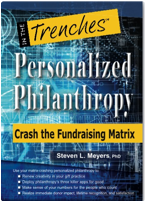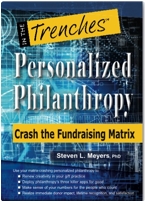
Bruce Bigelow in Partnership for Philanthropic Planning [PPP]
Posted on June 9th, 2015

FRDNY: Going to NY. Even if I have to walk.
Posted on May 18th, 2015

- Profile four donors you encounter every day to better fine tune and personalize your gift designs
- Apply three killer apps of personalized gift design that can help you raise more money
- Revise your definition of philanthropy to one that works for both fundraisers and donors

Matrix crashing at FRDNY: in by 9/out by 5
Posted on May 13th, 2015

Please join me at
Fundraising Day in New York 2015
Learn about Fundraising Day in New York 2015. View now>
It's a privilege and a genuine hoot to be presenting in the advanced track of AFP's fabulous FRDNY!
Here's the program.
- Profile four donors you encounter every day to better fine tune and personalize your gift designs
- Apply three killer apps of personalized gift design that can help you raise more money
- Revise your definition of philanthropy to one that works for both fundraisers and donors

AFP's “Advancing Philanthropy” Discovers Grail of Fundraising
Posted on April 11th, 2015

Why Philanthropy Should Matter to Advisors, by Tim Belber
Posted on April 9th, 2015
By Timothy Belber
Key Takeaways:
- Many advisors greatly underestimate their clients’ interest in philanthropy.
- Studies show less than half of HNW clients are satisfied with the philanthropic conversations they have with advisors.
- Helping clients with philanthropic planning gives you an emotional connection with current (and future) generations that goes far beyond traditional tax, investing and insurance. It can also help you retain AUM.
To many advisors, philanthropy is at best a tax strategy or a "check off the box" conversation. It should be far more important to advisors. It certainly is to high-net-worth (HNW) families. As The Philanthropic Initiative 2013 Study on the Philanthropic Conversation found:
Advisors and clients disagree about the focus of their philanthropic conversations. Advisors believe their philanthropic discussions are equally balanced between their clients’ personal goals/interests and technical topics, but most HNW consumers say their advisors primarily focus on the technical aspects of giving, including tax consequences. HNW consumers want advisors to adopt a more balanced approach, focusing on both their personal passions/charitable interests and technical topics. Less than half of HNW consumers are fully satisfied with the philanthropic conversations they have with advisors, likely influenced by this disparity in advisor focus and client desires.
I can tell you from experience that creating a more satisfying experience with families around philanthropy generates real benefits for financial advisors. First, you are connecting with your clients at an emotional level far beyond the traditional tax/investing/insurance premiums level. Second, being involved in true family philanthropy creates the opportunity to get to know and work with the coming generations. Done correctly, a family philanthropy program can be empowering for all family members. Third, as you become involved with your client’s philanthropic interests you will find yourself meeting, on a very favorable nontechnical basis, other families similar to your client. Last, creative philanthropy, as we’ll see, can actually help you retain AUM or implement other financial strategies.
Four essential conversations
How does it start? I have found four conversations useful in helping families think about philanthropy.
1. The Legacy Conversation
Legacy is a word that means different things to different people. The definition I use with clients is simple:
What do you want (your children/grandchildren/someone) to feel, think and say when they hear your name?
That leads to the next questions:
How does your current approach to philanthropy support your Legacy Statement? Should we explore ways to better align those two?
2. The Gratitude ConversationI often hear statements such as "My children/grandchildren don’t appreciate what they have!" or "I wish my children were more grateful for what I have given them."
In Strangers in Paradise, Dr. James Grubman lays out an interesting reason that so many wealth earners make this complaint: It’s for the same reason I cannot appreciate the freedoms of living in the United States nearly as much as someone who emigrates here from Cuba or North Korea does.
Children (and often grandchildren) of wealth holders do not appreciate what they have for the very same reason we do not appreciate so many things in life: We are born into them.
If you were born in the United States, or in almost any modern country, you take things like electricity, plumbing and the telephone for granted. You have probably had them for your entire life. On the other hand, someone who emigrates from a small remote village in Africa to the United States will marvel at the flush toilet. He or she will look at you and me and say, "You don’t appreciate what you have!"
Family philanthropy can be a way of bringing gratitude to life. A simple gratitude exercise (name three things you are grateful for today) followed by a conversation about how you can express that gratitude through philanthropy is an eye-opening experience for families.
3. The Sustainability Conversation
HNW families enjoy life in many different ways. Being mindful of what it takes to have and sustain that world is another entry point into meaningful family philanthropy. The opening question is, "What about your world today do you want your family to enjoy for future generations?" This is followed by the questions, "Have you ever considered what it will take to sustain that?" and "Have you discussed this with your children?"
Real-world example
The best example I have seen is a family vacation home in a ski resort community. Most families are not mindful of what it takes for them to fly in, enjoy the mountain, eat great food and have an overall wonderful experience. It requires a lot of people who also want good housing, educational opportunities for their children and good health care. Keeping the environment of the mountain pristine is also critical to the experience. Sustaining the family’s overall mountain experience for coming generations requires a commitment from the family to support organizations in the resort community, such as a local scholarship foundation or various environmental philanthropies. I’ve seen families base most of their philanthropic giving around this idea because they see philanthropy as more of a two-way street with returns flowing back to them instead of the old one-way street benefiting the charity alone.
I met with Pete, a longtime client, to discuss the agenda for our next family meeting. The primary topic was philanthropy and understanding how you uncover your own philanthropic capacity. This was a good-size family: parents (mid 60s), three married children and ten grandchildren. They had a significant family net worth in the range of $750M, mostly illiquid with good cash flow. They had a liquidity event on the horizon, but not anytime soon. I’ve done planning, education, life insurance and a variety of things for them over the past 15 years.
After reviewing my proposed agenda, I asked the family patriarch, Pete, what his current thoughts on philanthropy were. He said one of his dreams was to endow a chair at his alma mater, a great engineering school. I asked what that required, and he replied it would take between $1.5 million and $5 million, depending on the chair. Prior to learning about Dr. Meyers’ ideas, my response would have been that we should add that sum into how we plan for the liquidity event.
But I asked Pete if he was familiar with the "spend rate" on endowments. He said he was and that he understood it to be between 4 percent and 5 percent. I was surprised he knew about spend rate, and he commented it was because of the number of boards he sits on. So I laid out the idea of a virtual endowment with annual gifts of $60,000 to $70,000, followed by a "completion gift" from the liquidity event or from his estate—all formalized in a "pledge agreement."
Pete loved the idea and said it would give him "great joy" to be able to see a chair from his family sooner rather than later. He was able to hold onto the principal in an investment account while getting the satisfaction, impact and recognition he desired.
Pete is setting up lunch for the foundation president and me to talk about the power of alternative strategies to improve giving and donor satisfaction. He also wants to talk about some of the other causes he is involved with to see how I may be able to help donors to those causes.
To me, this underscores the importance of financial planners, estate planners and other family advisors gaining an understanding of family philanthropy in general and personalized philanthropy in particular. It is putting me in front of the families I want to talk to and is helping important causes sustain the vital work they do.
Partner and Monetize: Staging Your Gift with Personalized Philanthropy (you really should read this)
Posted on April 5th, 2015

|
The case Phil Cubeta makes for advisors to look into Personalized Philanthropy begins with self-interest (AUM) … and goes well beyond.
Philanthropy and AUM
Often investment advisors are held back in serving the client's philanthropy by the fear, partly justified, that the gifts to charity, if significant, will come at the expense of assets under management. As discussed in a prior post, however, we are on the cusp of a major historical opportunity to help Boomer business owners in transition from success to significance, and also greatly increase and retain assets under management. |
The Grail Challenge: Go "Slightly Viral"
Posted on March 28th, 2015


Blue Screen
Posted on March 8th, 2015

- Rise above the culture war between institution-focused and donor-focused fundraising.
- Design and shape gifts to mesh compelling interests with compelling need.
- Deploy personalized philanthropy's three killer apps for good
- Realize the holy grail of fundraising: immediate donor impact, lifetime recognition and satisfaction
- Structure engagements utilizing a personalized gift design process to move beyond conventional solicitations.
- Make sense of your numbers for the people who count.
- Renew creativity in your own gift planning practice and help lead your development team to donor-focused giving

Matrix has landed!
Posted on March 2nd, 2015


Engaging donors for impact and recognition now.
We can show you how.
Use Order code personalized-philanthropy for a 25% discount and free shipping
Everyone has a plan, until they are punched in the face
Posted on February 19th, 2015

Personalized Philanthropy. For both fundraisers and philanthropists. When we say we want to get it right, what do we mean? “The right gift, for the right purpose, for the right donor.” It's about innovative donor-focused, individually-tailored giving strategies -- new gift applications that combine current and future gifts, so that donors can create a lasting legacy where recognition and impact begin now. To make miracles happen at charitable organizations close to their hearts. ~Steven L. Meyers, Ph.D., Founder, Personalized Philanthropy

